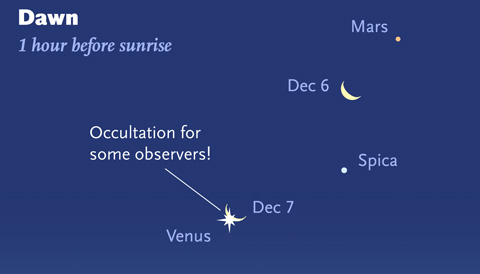Tour December’s Sky: Planets and Meteors
This month offers great variety in the night sky: planets (and a comet!) before dawn, a strong meteor shower, and a parade of bright stars after sunset.
With the solstice occurring at 11:48 p.m. Eastern Standard Time on the 21st, December offers northern observers the longest nights for stargazing all year — and there's plenty to see!

Venus and Jupiter anchor a pretty predawn sky during December. A thin crescent Moon adds some drama on the 6th and 7th.
Sky & Telescope diagram
Sky & Telescope diagram
You'll find many of the best sights in the eastern sky before dawn. Venus and Jupiter are dazzling, with the bright star Spica and Mars sandwiched between them. A thin crescent Moon is perched dramatically close to Venus on December 7th. That same morning, Comet Catalina (C/2013 US10) is just a few degrees to the left of Venus, and it might be bright enough to just barely appear as a fuzzy star. Binoculars will help.
Later in the month, on the nights of December 13th and 14th, we'll be treated to the Geminid meteor shower. With moonless skies and good viewing prospects this year, you might see at least one of these "shooting stars" per minute from a dark location. A few Geminids should be obvious by 10 p.m. — but the later you stay up, the more of them you'll see.
Throughout December, you'll see bright stars parading across the sky after sunset. Vega and the Northern Cross of Cygnus are over in the west, while Orion, Taurus, and Gemini dominate the east.
To get a personally guided tour of the night-sky sights overhead during December, download our 7½-minute-long stargazing podcast below.
No comments:
Post a Comment